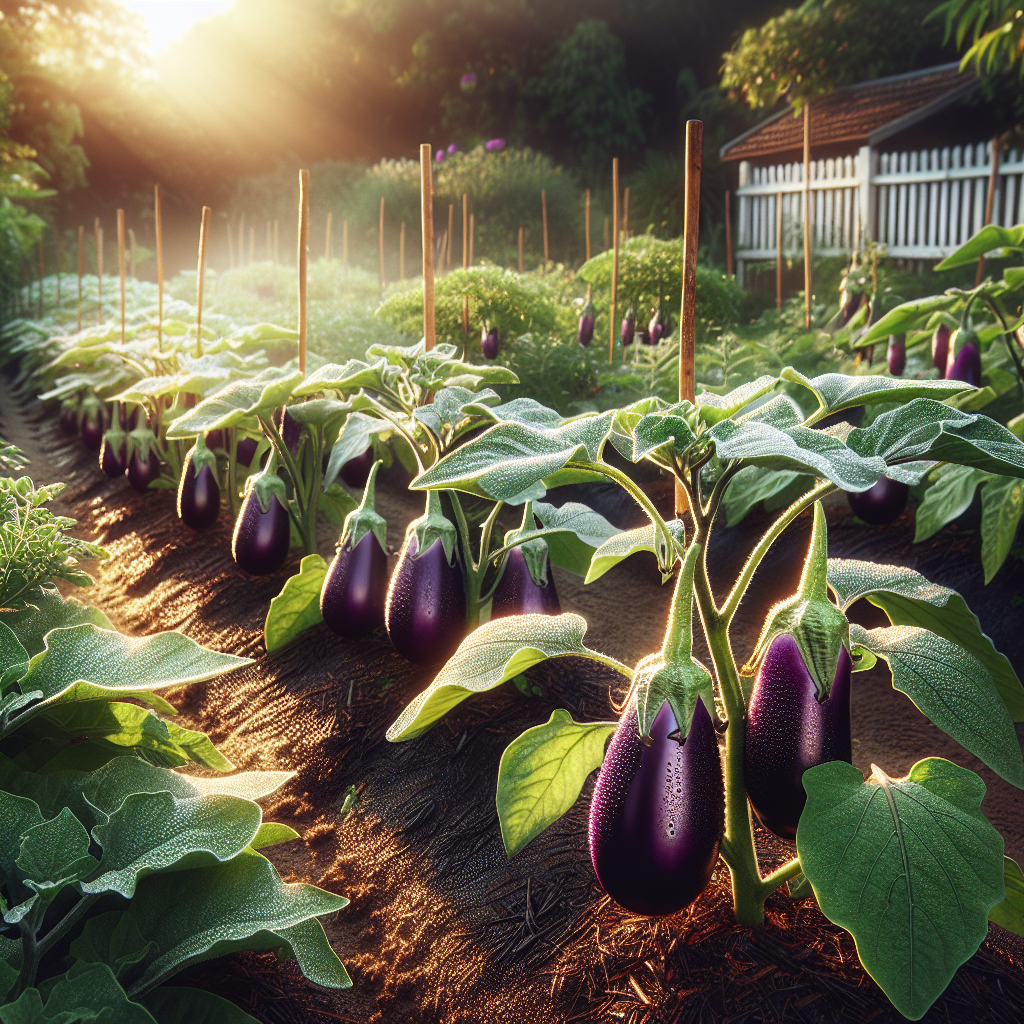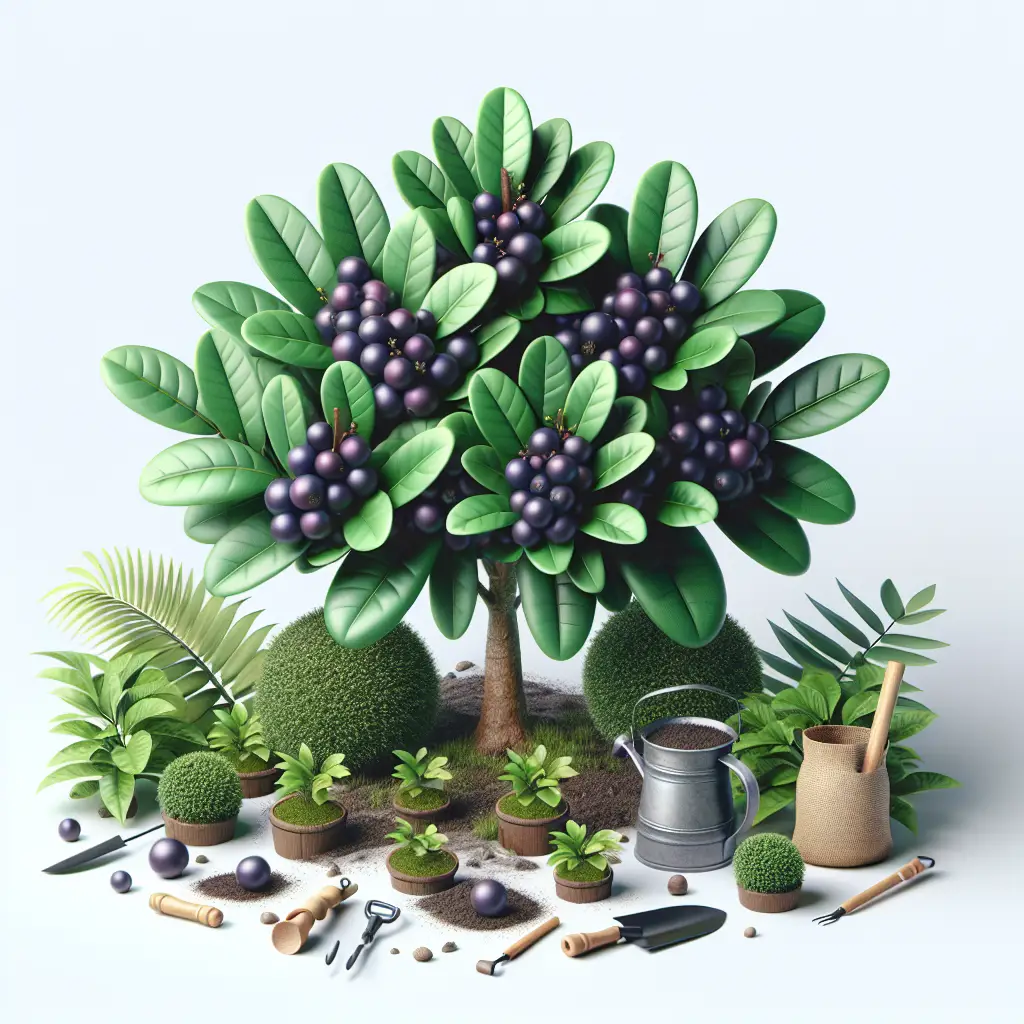Preventing Blossom End Rot in Eggplants
Updated May 4, 2024 at 7:57 am
Learn how to identify and combat blossom end rot in eggplants, ensuring your garden produces healthy, bountiful crops free from this common yet preventable issue.

“`html
- Pet Friendly: Generally, eggplants are non-toxic to pets; however, caution should be exercised as certain parts of an eggplant, especially the leaves, can be harmful if ingested.
- Light Requirements: Eggplants require full sun to develop fully, which equates to at least 6 to 8 hours of sunlight per day.
- Watering: Consistent watering is key to preventing blossom end rot, with deep watering at least once a week or more during dry spells.
- Humidity: Eggplants are not particularly humidity sensitive, but they do appreciate moderate conditions without extremes.
- Temperature: Warm temperatures are preferable for eggplants, with ideal growth occurring between 70-85°F (21-29°C).
- Difficulty: Growing eggplants can be moderately challenging due to their need for consistent care and monitoring for diseases like blossom end rot.
Understanding Blossom End Rot in Eggplants
Blossom end rot is a heartbreaking issue for many gardeners who anticipate the rewards of their labor in the form of healthy eggplants. This condition appears as a dark, sunken area at the bottom of the fruit, which can expand and turn into a leathery, brown spot, rendering the eggplant unpalatable and inedible.
Now, if you are passionate about caring for plants, you might want to dive deeper into expert indoor plant care. While eggplants thrive outdoors, understanding the basics of plant nurturing can be quite advantageous.
What Causes Blossom End Rot?
Blossom end rot is primarily caused by calcium deficiency within the plant. While soil might have adequate calcium, fluctuations in soil moisture can impede its uptake, leading to the characteristic symptoms in the fruit.
It’s important to realize that this is not an infectious disease but more of a physiological issue linked to the plant’s environment and care. For those fascinated by the impact of environmental conditions on plant health, exploring how to keep your green friends thriving in low-light settings can provide helpful insights for overall plant maintenance.
Preventative Measures Against Blossom End Rot
To stave off blossom end rot, focus on consistent watering. Overwatering or under-watering can both lead to calcium uptake issues. Soil should be kept evenly moist, not waterlogged or dry. Using mulch can help retain soil moisture and regulate temperature.
Avoidance of excessive nitrogen in fertilizers is also important. High nitrogen levels encourage leaf growth at the expense of fruit development and can exacerbate calcium deficiency in fruits. Opt for fertilizers formulated specifically for vegetables or fruiting plants.
For those striving to master their green thumb across various plant species, uncovering secrets for fostering ferns in low-light conditions can be equally applicable in managing nutrient absorption for optimal plant health.
Soil and Fertilization Techniques
Begin with well-draining soil that has been amended with compost or well-rotted manure to provide a rich, yet aerated foundation. A soil test can reveal calcium levels and pH, guiding the correct amendment applications such as the addition of lime to raise calcium levels and decrease acidity.
When selecting fertilizers, avoid those with high nitrogen content and select those which contain calcium, or consider the use of bone meal as a supplement. Consistency in fertilization throughout the growing season is key.
Balancing Soil pH for Healthy Eggplants
Ensuring that soil pH levels are between 6.0 and 6.5 can greatly support calcium uptake. If a soil test indicates that the pH is too high or too low, amendments like sulfur or lime can be used to adjust it accordingly.
Keep in mind that changes to soil pH take time to have an effect, so it’s best to prepare the soil several months in advance of planting.
“`
Identifying Early Signs of Blossom End Rot
Careful observation is crucial in preventing extensive damage from blossom end rot. Initially, a small, water-soaked spot appears on the blossom end of the fruit. This spot will enlarge and darken as it progresses.
Gardeners should be vigilant, frequently inspecting their eggplants for these early symptoms. When caught early, adjustments can be made to lessen the impact, such as modifying irrigation practices.
Effective Watering Strategies to Combat Blossom End Rot
Water is vital to healthy plant growth and particularly in regulating nutrients like calcium. Implementing a drip irrigation system can provide a slow, steady supply of water, allowing plants to absorb moisture and nutrients efficiently.
Moreover, this method minimizes water wastage and prevents the soil from becoming too wet, which can be especially handy if you’re maintaining various types of plants that have different moisture requirements, like the ones illustrated in low-light plant care guides for ZZ plants.
Mulching: A Dual-Purpose Solution
Mulching is a gardener’s ally in moisture retention and temperature control. A layer of organic mulch, such as straw or leaf compost, can help maintain soil hydration and deter rapid evaporation.
This practice not only aids in the combat against blossom end rot but also contributes to a healthier, more sustainable garden ecosystem by enriching the soil as the mulch decomposes over time.
Selecting the Right Varieties of Eggplants
Certain varieties of eggplants are more resistant to blossom end rot than others. Before planting, research and select varieties known for their resilience to this condition. Seeds or seedlings from reputable suppliers can also help ensure healthy, robust plants.
When optimizing plant health, aligning variety or species selection with environmental conditions can lead to greater success, much like the considerations one would make when selecting Calathea plants best suited for low-light rooms.
Monitoring Plant Growth and Health
Steady growth is essential to avoid stress that can trigger or worsen blossom end rot. Regularly inspect plants for pests, diseases, or nutrient deficiencies that might contribute to inconsistent growth patterns.
Suitable stake or cage support for eggplants can alleviate stress on the stems and roots, promoting healthier fruit development. Similarly, providing the right support and care for one’s plants is akin to the detailed instructions on cultivating Philodendron goeldii effectively indoors.
Role of Calcium Supplements in Preventing Blossom End Rot
If soil tests show a calcium deficiency, calcium supplements can be a direct line of defense against blossom end rot. Agricultural lime, gypsum, or calcium nitrate are commonly used to enhance calcium levels in the soil.
It is important to follow recommended application rates and intervals for these supplements. Overuse can lead to imbalances in the soil that could negatively affect plant growth.
Treating Blossom End Rot with Organics
Organic gardeners have options as well, such as eggshell calcium or foliar applications of calcium-rich solutions. Crushed eggshells can be added to the soil prior to planting or used as a side dressing during the growth cycle.
While mild cases of blossom end rot can self-correct as the season progresses, employing these organic methods aids the plant’s recovery and supports overall plant health. If you appreciate organic gardening, you might also be interested in the holistic approach to creating a pollinator-friendly vegetable garden.
Plant Nutrient Balance and Blossom End Rot
While calcium is critical, a balanced nutrient profile is important for eggplant health. Ensure that plants receive a well-rounded diet that includes potassium and phosphorus, in addition to calcium, to support robust growth and fruit development.
Regularly applying a balanced, all-purpose vegetable fertilizer can maintain the nutrient balance, but be sure not to over-fertilize, as this can lead to other problems, including increased susceptibility to blossom end rot.
Adapting to Environmental Stressors
Eggplants, like many plants, can be affected by environmental stressors such as extreme temperatures, high winds, or unusually rainy or dry seasons. Adjusting care to adapt to these conditions can help prevent blossom end rot.
In areas of high heat and intense sun, using shade cloths during the hottest parts of the day may prevent stress on the plants. Similarly, during extended rainy periods, increased soil drainage may be necessary to prevent waterlogged conditions that disrupt calcium uptake.
Conclusion and Content area 3 of 3
By addressing these elements proactively, gardeners can greatly reduce the risk of their eggplants suffering from blossom end rot. Implementing these strategies requires patience and observation but can ultimately lead to a bountiful harvest of healthy eggplants.
Understanding the Role of Consistent Care in Preventing Blossom End Rot
Beyond the direct causes of blossom end rot, consistent and attentive care plays a significant role in prevention. Regular checks on your eggplants can alert you to small changes in the plant’s health before they become more serious problems.
For example, you might regularly check the color of the leaves, the firmness of the fruit, and the condition of the soil to gauge your plant’s well-being. It’s just like when one cares for Aglaonema, paying attention to subtle signs can be the difference between a thriving plant and one that struggles.
Community Insights and Knowledge Sharing
Learning from other gardeners and horticulturists can provide valuable insights into preventing blossom end rot. Community gardens, online forums, and local clubs often have a wealth of knowledge and are a great way to understand regional challenges and solutions.
It’s always a good idea to share your experiences and tips with others. Just as one might swap stories of triumph and failure in the care of bromeliads, the same is true for vegetable gardening. It fosters a sense of community and collective problem-solving.
Using Technology to Aid in Plant Monitoring
In our modern age, technology can come to the aid of gardeners aiming to prevent blossom end rot. Soil moisture sensors, pH meters, and climate control systems can provide accurate readings and help maintain the optimal environment for your eggplants.
While not all gardeners will opt for high-tech solutions, even simple gadgets can bring about a precise understanding of your plants’ needs, leading to healthier growth and reduced risks of issues like blossom end rot.
Analyzing Water Quality for Plant Health
The quality of water used in your garden can also affect the prevalence of blossom end rot. If your water is particularly high in salts or other minerals, it can interfere with nutrient uptake. Conversely, rainwater can sometimes be the best choice for watering your plants as it’s typically soft and free of chlorine or fluoride.
If you suspect that poor water quality is affecting your plants, consider testing the water or consulting with local agricultural extensions for advice. Cleaner water is not just crucial for plants; it’s similar to ensuring the air quality around your spider plants is not compromised by pollutants.
When to Seek Professional Help
If you’ve tried all the above suggestions and you’re still struggling with blossom end rot, it may be time to seek professional help. A local cooperative extension service or a trusted nursery can offer soil testing, advice on amendments, and tailored guidance for your situation.
Professionals can also help you understand if there are any underlying issues that might contribute to blossom end rot, such as pests or diseases, which you might not have noticed. It’s a helping hand that ensures you’re not overlooking any detail in your plant care routine.
Final Thoughts on Preventing Blossom End Rot in Eggplants
Preventing blossom end rot in eggplants is about much more than reacting to symptoms. It is about creating a consistent, sustainable environment where eggplants can thrive. It’s a combination of science, patience, practice, and sometimes, even embracing a bit of technology.
While this issue can be disheartening, don’t let it discourage you. Use it as a learning experience to improve your gardening skills. Over time, attentive care, balanced nutrition, and environmental management will lead to healthy, rot-free eggplants and a more enjoyable gardening journey.
Shop more on Amazon
Flowers & Plants Team
Flowers & Plants Team



